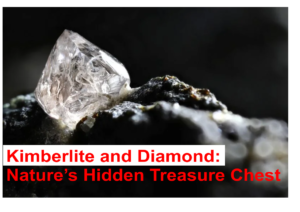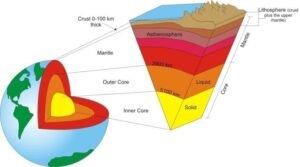When you think of diamonds, you might imagine glittering jewelry, extravagant proposals, or even Hollywood red carpets. But behind every diamond lies a fascinating geological journey that begins deep beneath Earth’s surface in a rock called kimberlite.
What is Kimberlite ?
Kimberlite is a rare, volcanic rock that acts as a carrier rock for Earth’s most precious materials: diamonds. Found mostly in old, stable parts of the Earth’s crust known as cratons, kimberlite forms from magma that originates over 150 kilometers (about 90 miles) deep, in the mantle, that scorching layer beneath the crust.
What makes kimberlite so unique isn’t just its deep origin. It’s the explosive way it travels to the surface. Kimberlite eruptions are like geological rockets. The magma moves so quickly that it brings with it materials from the mantle, including diamonds that formed under extreme pressure and temperature.
How Are Diamonds Formed?
Before diamonds ever meet kimberlite, their story starts in the mantle, under high pressure and temperatures exceeding 1000°C (1832°F). Under these extreme conditions, carbon atoms bond in a unique crystal structure that results in a diamond.
But here’s the catch: if diamonds stay in the mantle, they’re inaccessible and if they rise too slowly to the surface, they may turn into graphite (the stuff in your pencil) due to changing temperature and pressure. So they need a speedy escape route, this is where kimberlite swoops in like a geological superhero.

The Explosive Journey of Kimberlite Magma
Kimberlite magma forms deep in the mantle and contains volatile elements like carbon dioxide and water, which make it incredibly buoyant and explosive. When it starts rising, it moves toward the surface through cracks and weaknesses in the Earth’s crust.
During its journey, it tears off pieces of the mantle, crust, and anything in its way. These fragments, known as xenoliths, provide clues about the deep Earth. When it finally reaches the surface, the magma erupts explosively, creating vertical pipe-like structures called kimberlite pipes—the primary sources of mined diamonds.
These eruptions are so fast and violent that they’re over in a matter of hours, leaving behind crater-like features and a vertical pipe filled with broken rock and ash.

Kimberlite Pipes: The Diamond Hotspots
Not all kimberlite pipes contain diamonds, and not all diamonds in them are economically valuable. But some pipes like those found in South Africa, Russia, Canada, and Australia have produced millions of carats.
One of the most famous kimberlite sources is the Big Hole in Kimberley, South Africa, which sparked the diamond rush in the late 1800s. The discovery of diamond-bearing kimberlite here changed the world’s diamond industry forever. Modern mining now focuses on pipes that are rich in diamonds and easy to access. Geologists use satellite imaging, soil geochemistry, and geophysical surveys to locate hidden kimberlite pipes.
What Else Is in Kimberlite?
Kimberlite contains minerals like:
- Olivine – A green, glassy mineral from the mantle.
- Phlogopite – A shiny mica that gives clues about the magma’s chemistry.
- Ilmenite and Chromite – Indicator minerals that geologists track to find kimberlite.
- Garnet (especially G10 garnets) – Their presence is often linked with diamond potential.
By studying these minerals, geologists can predict whether a kimberlite is likely to host diamonds, even before any digging begins.
The Global Hunt for Kimberlite
Finding kimberlite is like searching for buried treasure. Since many pipes are buried under soil, forests, or even ice, exploration involves some pretty advanced science.
In Canada’s Northwest Territories, diamond-bearing kimberlite pipes were found under lakes and tundra using aeromagnetic surveys—where planes fly over land and detect magnetic anomalies caused by the iron-rich minerals in kimberlite.
In Botswana, exploration teams follow trails of indicator minerals like garnet and chrome diopside back to their source. These minerals are often more widespread than diamonds themselves and act like breadcrumbs leading to the motherlode.
Kimberlite vs. Lamproite
While kimberlite gets most of the fame, it’s not the only rock that can host diamonds. Lamproite, another volcanic rock, has also delivered diamonds to the surface. The Argyle Mine in Western Australia, famous for its rare pink diamonds, is hosted in lamproite.
Lamproite magmas form slightly differently, often in areas with more complex tectonic histories. But just like kimberlite, they erupt quickly and bring deep-mantle materials to the surface.
Are All Diamonds from Kimberlite?
Nope! Some diamonds come from alluvial deposits, where erosion carries diamonds from their original kimberlite pipe into rivers or coastal sands. These diamonds may have traveled miles from their source, worn smooth by time and water.
These alluvial diamonds are often easier to mine and have been historically significant, especially in countries like Sierra Leone, Angola, and Brazil.
FAQs on Kimberlite and Diamond
1. What is kimberlite?
Kimberlite is an ultramafic, volatile-rich igneous rock that originates deep in the Earth’s mantle and is the primary host rock for natural diamonds. It is typically found in vertical, pipe-like structures known as kimberlite pipes.
2. How is kimberlite related to diamonds?
Kimberlite acts as a carrier rock for diamonds. It forms deep in the mantle, where high pressure and temperature allow diamonds to crystallize, and rapidly erupts to the surface, preserving the diamonds during transport.
3. What is a kimberlite pipe?
A kimberlite pipe is a carrot-shaped geological feature formed by explosive volcanic eruptions that bring kimberlite and diamonds from the mantle to the Earth’s surface. These pipes are the most significant sources of mined diamonds.
4. Where are kimberlites commonly found?
Kimberlites are mainly found in cratonic regions—ancient, stable parts of continental lithosphere. Notable regions include South Africa, Siberia, Canada, Brazil, and parts of India (e.g., Andhra Pradesh and Madhya Pradesh).
5. What minerals are associated with kimberlites?
Common minerals in kimberlite include olivine, phlogopite, pyrope garnet, diopside, ilmenite, and sometimes chromite. These minerals are used as indicator minerals in diamond exploration.
6. How are diamonds formed?
Diamonds form in the Earth’s mantle at depths greater than 150 km, under high pressure (>45 kbar) and temperatures (900–1300°C). Carbon crystallizes into diamond over millions to billions of years before being transported by kimberlite magma.
7. Why is rapid eruption important for diamonds?
Diamonds are metastable at Earth’s surface conditions. A rapid kimberlite eruption is necessary to transport them quickly from the mantle to the surface without converting them to graphite, their stable form at low pressure.
8. Are all kimberlites diamond-bearing?
No, not all kimberlites contain diamonds. Only a small percentage are “diamondiferous,” depending on the original carbon source, pressure-temperature conditions, and preservation during transport.
9. What are indicator minerals, and how are they used?
Indicator minerals like pyrope garnet, chromian diopside, and ilmenite are resistant to weathering and can be found in soils and stream sediments. Their presence suggests a possible nearby kimberlite source and aids in diamond exploration.
10. What is the age of most kimberlite intrusions?
Most kimberlite intrusions are from the Proterozoic to Cretaceous periods, ranging from around 2 billion to 70 million years old. Their eruption is often linked to deep mantle plume activity and lithospheric extension.
11. What makes kimberlite eruptions unique?
Kimberlite eruptions are extremely explosive due to high volatile content (CO₂, H₂O). They originate from great depths and are among the fastest known magma ascent processes on Earth.
12. What role does plate tectonics play in kimberlite formation?
Kimberlite magmas are often linked to continental rifting or intraplate tectonic activity. The thinning lithosphere and underlying mantle plumes create the conditions necessary for kimberlite magma to form and erupt.
13. How are kimberlites mined?
Kimberlites are mined through open-pit or underground mining methods, depending on the depth and economic viability of the pipe. The rock is crushed and processed to recover diamonds.
14. Are there other diamond host rocks besides kimberlite?
Yes, lamproite is another igneous rock type that can host diamonds, although it is less common. The Argyle Diamond Mine in Australia is a famous example of diamonds found in lamproite.
15. What is the economic importance of kimberlites?
Kimberlites are crucial to the global diamond industry. They are the primary source of natural diamonds, which have significant industrial and gemstone value, making them economically important for mining nations.






Are the volcanic stacks in Arizona the wrong kind for diamond formation??